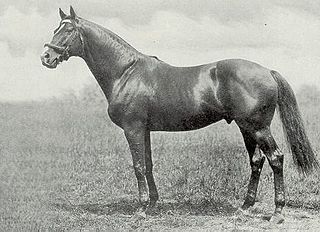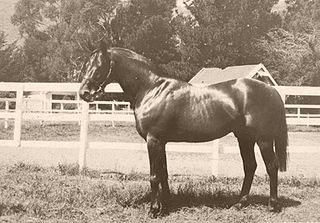
Carbine (1885–1914), was an outstanding New Zealand bred Thoroughbred racehorse, who competed in New Zealand and later Australia. During his racing career he won 30 stakes or principal races. Owing to his performance on the track and his subsequent achievements as a sire, he became one of five inaugural inductees into both the New Zealand Racing Hall of Fame and the Australian Racing Hall of Fame.

The racing of Thoroughbred horses is a popular sport in New Zealand. The governing body is New Zealand Thoroughbred Racing Incorporated. The principal racing club, the Auckland Racing Club, races at Ellerslie Racecourse.
Bonecrusher was a champion New Zealand Thoroughbred racehorse who was widely admired in both Australia and New Zealand.

Musket (1867–1885) was an English-bred Thoroughbred racehorse and a Leading sire in Australia and New Zealand.
Balmerino was a bay Thoroughbred stallion that was foaled at Cambridge in the Waikato region of New Zealand. He later became a champion racehorse with many international successes.
Xcellent is a thoroughbred racehorse who was trained by Michael & Paul Moroney.
Crepello (1954–1974) was a British-bred Thoroughbred racehorse which won England's most prestigious race, the Derby in 1957 and was later a Leading sire in Great Britain & Ireland.

Blue Peter (1936–1957) was a British bred Thoroughbred racehorse whose career was cut short by the outbreak of World War II. He won The Derby and was later a Leading broodmare sire in Great Britain & Ireland.
Castletown was a New Zealand thoroughbred racehorse who won over $2 million in prize money and is best known for winning one of New Zealand's toughest staying tests, the Wellington Cup, on three occasions. He had over 100 starts, from two to eight years of age, including a record 13 races over 3,200 metres, a distance at which he excelled. Over the distance, he won the Wellington Cup in 1991, 1992, and 1994, and the Auckland Cup in 1992. In his third win in the Wellington Cup, Castletown carried topweight of 58 kilograms, and won a special place in New Zealand racing history, accompanied by the memorable "the dream bursts into reality" commentary from Tony Lee. Castletown could also be effective over shorter distances, especially earlier in his career, where highlights included wins in the New Zealand Derby, the Kelt Capital Stakes, and the Caulfield Stakes, and he was placed in stakes races as short as 1,600 metres. In Australia, he contested the Caulfield and Melbourne Cups three years in-a-row, from 1991 to 1993, and the Sydney Cup in 1991 and 1992. He was placed in both Sydney Cups, and finished third to Subzero and Veandercross in his second Melbourne Cup, in 1992. He failed to recapture his best form after his last Wellington Cup, and ran his last race in November 1994. He died in December 2017 of cardiac arrest.

The Flying Dutchman (1846–1870) was an English Thoroughbred racehorse and sire. He raced for four seasons between 1848 and 1851, winning all but one of his fifteen races, including The Derby and the St Leger. On his final racecourse appearance he defeated Voltigeur in what was probably the most celebrated match race in the history of British thoroughbred racing, known as The Great Match. He went on to be a success at stud both in Britain and France, where he died in 1870. The Flying Dutchman was regarded by experts as one of the greatest British racehorses of the nineteenth century.

Hurry On was an undefeated British Thoroughbred racehorse and sire that revived the Matchem sire line. English trainer Fred Darling called Hurry On the best horse he ever trained.
Isle Of Man was a thoroughbred racehorse known mainly for winning the New Zealand Derby in 1981. He went on to win the 1982 Rosehill Guineas.
Ring The Bell was a Thoroughbred racehorse who won the New Zealand Derby in 1981, the second Derby win in three years for trainer Neville Atkins. As a yearling, Ring the Bell had been sold for $3,000.

Night Raid was a Leading sire in Australia of Thoroughbred racehorses. He sired two leading racehorses, namely Phar Lap and Nightmarch.
Il Vicolo was a New Zealand Standardbred racehorse. He is notable in that he won two New Zealand Trotting Cup races, the richest harness race, and sometimes the richest horse race in New Zealand.

Court Martial was a Thoroughbred racehorse bred and raced by Lord Astor best known for defeating two exceptional colts in Dante and Royal Charger for the Classic 2000 Guineas Stakes and as a two-time leading sire in Great Britain and Ireland.
Pay Up was a British Thoroughbred racehorse and sire. As a two-year-old in 1935 he showed promise as he won one race and was place in his other three starts. In the following spring he won the Free Handicap and then recorded his biggest success in the 2000 Guineas. He started favourite for Epsom Derby but finished fourth, sustaining leg injuries which ended his track career. He had little success as a breeding stallion.
St Louis was an Irish-bred, British-trained thoroughbred racehorse and sire. He finished unplaced on his only start as a juvenile but made rapid improvement over the winter and won the 2000 Guineas in April 1922. He finished fourth when favourite for the Epsom Derby and then won a minor race at Wolverhampton Racecourse but was withdrawn from the St Leger after running poorly in a trial race. After failing to win on his only run as a four-year-old he was retired to stud, but had no success as a breeding stallion.
Tide-way was a British Thoroughbred racehorse and broodmare. She was rated one of the best British two-year-old fillies of 1935 when she won twice from four starts. She won the 1000 Guineas on her debut as a three-year-old but finished unplaced in the Epsom Oaks and never ran again. As a broodmare she produced the Eclipse Stakes winner Gulf Stream.









